It was really a kind of pilgrimage. I set off from
outside William Baines' one time residence in Albemarle Road, York with
the intention of retracing his steps to Flamborough Head near Bridlington.
It must begin as it will end, with a quotation from his diary dated
25th February 1918, 'How quiet and calm it will be at
Flamboro' today amongst the caves- what joy to picture.'
It was with that thought in mind that I joined the
traffic heading out of the medieval city.
It was a slow start to the journey; traffic is much
heavier than the days before the First World War when the composer had
cycled a route similar to that which I was about to take. Baines used
his bicycle and I took the car, not because I balked at pedalling some
45 miles - it is just that the roads are so busy that I would feel in
constant peril for my life perched on a 'sit up and beg'.
So the Fiat reached the outskirts of York - the ring
road crosses under the Bridlington Road at Grimston Bar. Soon the countryside
beckons and I am motoring through the attractive one-sided village of
Gate Helmsley. I wondered if Baines had called in at the inn here for
a light refreshment. Before reaching Stamford Bridge Baines would have
cycled under the York to Beverley railway line, however this was axed
in the 1960s and only the viaduct over the Derwent is left intact.
Stamford Bridge itself supposedly inspired a piano
piece that was never composed. He wrote in his diary for June 15th
1918, '…thought of two new names for pieces: 'At Dawn on the Wolds'
and 'Hedge Bottom one June Morn'. This second title had apparently
come from seeing roses and creepers in a hedge bottom near the village.
I bought a few provisions at Stamford Bridge and headed
out towards Garrowby Hill. How glad I was not to have brought my bicycle
as I approached this steep climb. This is a long slow drag up onto the
Wolds. Lord Halifax's house is always screened by the trees - but I
know that he has one of the best views in Yorkshire. The Fiat sailed
up the hill whereas Baines would have pushed his bicycle for nearly
a mile. Then it is the open road - on top of the world - Fridaythorpe,
Wetwang and Garston on the Wolds. I wondered if William had ever visited
the marvellously tiled church here? It is a short drive to Driffield
and then the last lap to Bridlington. After Burton Agnes with its stunning
hall and the village of Carnaby, the sea is in view. It is not long
before the Fiat and William Baines would have been on the sea front.
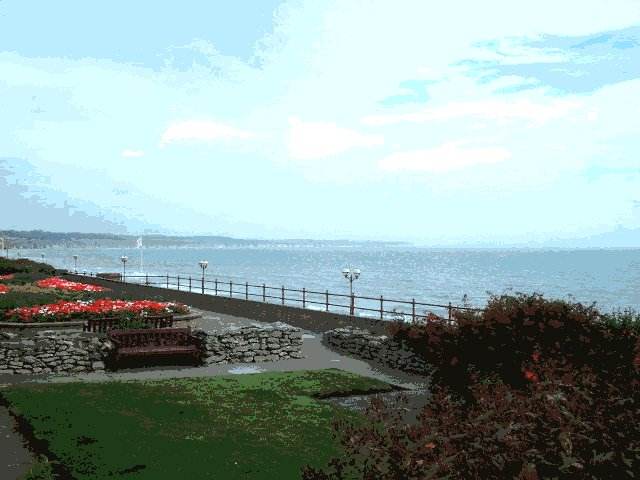
View of Flamboro' Head from the Promenade at Bridlington
Why should we consider making a pilgrimage to one of
the haunts of William Baines? What is there about his music that requires
a trip to Flamboro' Head? Hopefully some answers to these questions
will emerge below.
A few brief notes about the composer's life and works
will not be out of place here.
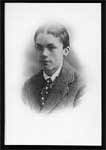
William Baines aged 18
William Baines was born at Horbury in the West Riding
of Yorkshire on 26th March 1899. His father was a chapel
organist and a cinema pianist. The young Baines was encouraged to learn
the piano. When he was eleven years old he had formal lessons in piano
and in harmony and counterpoint at the Yorkshire Training College of
Music in Leeds. He was advised in his musical studies by Frederick Dawson.
Baines was soon to apply this knowledge in the composition of chants,
hymn tunes and piano pieces. He was to become largely self-taught in
his orchestration skills by perusal of scores and attendance at symphony
concerts.
When William was 18 years old the family moved to York.
Baines senior and junior both had employment as cinema pianists. 1917
was a momentous year for the composer; he gave his first public piano
recital at which a number of his own works were heard and he wrote his
excellent and undervalued symphony. It was not to be heard until 1991.
In 1918 Baines was conscripted. He had a weak constitution
and was really in no fit state to be an active combatant. However at
that time the Germans were mounting 'one last push' and all able and
less than able-bodied men were being pressed into service. Baines military
career was to be short-lived. Within a fortnight of his call up, he
had septic poisoning and was hospitalised. By the time of his recovery,
the war was over. He was never to be fully restored to health.
He continued to compose and give piano recitals until
a few months before his death. His only major excursion was to Bournemouth
at the invitation of Sir Dan Godfrey in 1921. There he gave a performance
of his piano work Tides. It was only nine days after Bax's Tintagel
had been played in the same Pavilion.
Baines was to die from tuberculosis on 6th November
1922. He was aged 23.
William Baines wrote about a 150 works in a number
of genres, including a symphony, a piano concerto and chamber works.
However it is his piano compositions that are perhaps his most successful
and enduring achievements. He worked better as a miniaturist rather
than on larger canvases. Many of his piano pieces could be described
as impressionistic, ranging through a variety of moods and styles. It
is not fair to try to attach influences to Baines, but it must be said
that the works of Scriabin were seminal. Add to this the unique but
underrated achievement of Cyril Scott and we have some idea of how Baines
approached the timbres of the piano. He was able to fuse the style of
the Russian with that of English Pastoralism and Romanticism. His music
covered a range of emotion and styles; his harmonies could be rich or
sparse. Grove’s Dictionary (2001/02) points out that perhaps the key
to Baines style is his Seven Preludes composed in 1919. It is
here that many of the aspects of his style are apparent - 'from virtuoso
brilliance to rhapsodic contemplation, and from a lush Romanticism to
sparse textures and acrid harmonies.' Frederick Dawson, Baines' music
adviser, once wrote that the young composer had "an inexhaustible
fancy and the enviable gift of translating into terms of sound his love
of Nature and his joy in the beautiful"
Much of his music was imbued with his love of nature,
especially the countryside of East Riding and the seascapes of Flamboro'
Head. At one time the convalescing Baines chose to spend time close
to his beloved landscape in spite of being offered a shooting cottage
in the Hebrides by Lord Howard de Walden.
But it is to Flamboro Head that we turn our footsteps
and our attention. Now, although everyone living in Yorkshire will know
where this great natural feature is and what it looks like, it will
help to give a brief, if somewhat prosaic description. It is a large
chalk promontory, a part of the Yorkshire Wolds, reaching for some five
miles into the North Sea. The entire Head is surrounded by cliffs, some
360 feet above sea level. The top is mainly arable farmland but has
also been colonised by caravans, chalets and bungalows. There are two
lighthouses - old and new, a fog horn station, coastguard station and
golf course. The whole area is covered by a network of well-marked footpaths
- one of which follows the cliff tops. The cliffs are honeycombed with
sea caves and the occasional stack. Erosion is a constant problem.
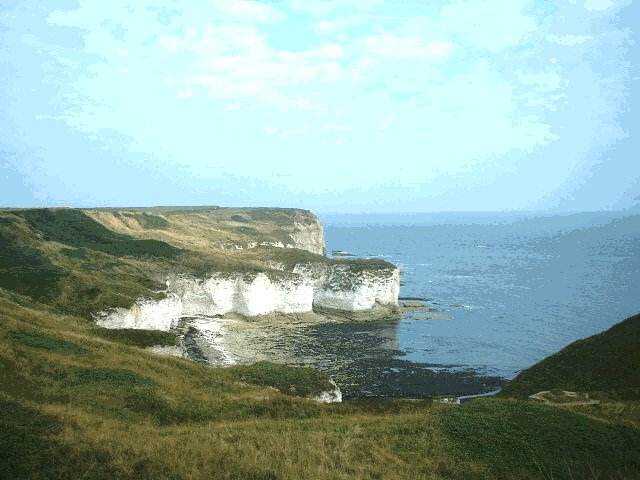
Selwicks Bay from the Lighthouse
From the cliffs it is possible to see down the coast
towards Bridlington and Withernsea. The beam from the lighthouse at
Spurn Point can be seen on a clear night. To the north are the Bempton
Cliffs with its wonderful sea-bird colonies and the coastline as far
as Scarborough and Filey. The hills of the North Yorkshire Moors and
the Wolds are clearly visible. There are two 'landings'- North and South.
Both allow the fisherman, life-boatman and tourist down to the sea.
There is an ancient earthwork, Danes Dyke running across the Head form
north to south.
This is the paradise that William Baines found so attractive
and inspiring.
Of course it is possible to see Flamboro' Head from
Bridlington, and how glorious and spectacular it looks. Baines must
have walked long the beach and the promenade on many occasions. In fact
a number of his diary entries refer to seeing the Head from afar. On
July 18th 1920 Baines wrote, Flamboro' is wonderfully
happy in its sadness. Earlier he had written, I had a long walk
and a loiter on the sands, filling my lungs with fresh air. The silver
sheen on the water was lovely. This evening Auntie and I went on the
Parade and listened to the orchestra - did not enjoy it much -but amused
ourselves watching the people. Flamboro' lighthouse looks very fine
at night time, flashing alternately red and white - and the ships and
vessels at sea just carry one light…It is all so sad at night…October
6th 1919
One evening he went for a cruise out of Bridlington
Harbour on board The Frenchman, 'Beneath a curling sky the water
was a lovely dark greeny green. As the waves overlapped one another
they appeared to be like running velvet…so soft and smooth. The light
was a bluey grey but a slanting sun kissed a strip of sea into a golden
pathway of light. The immensity of the ocean is wonderful, inexhaustable.
The great white Flamboro' cliffs stood fingering out in the distance.
Nature's great immovable symbols. Silent and dim…not a soul to be seen.
It must be lovely to be a seagull flying in those cathedral like caves
and glorious caverns.' As we sailed into the harbour, the gulls were
flying out to sea…out into the lonely grey which always seems to cloak
our beloved Flamboro' at night time. August 11th 1921
Certainly this nocturnal aspect of the scenery appealed
to Baines,
The sea is so restless…grim clouds hover about…through
the night air the shaft of light comes from the lighthouse at Flamboro'.
April 3rd 1920.
I set off from Brett Street, his aunt's residence,
in Bridlington and headed out towards Sewerby and Flamborough. I passed
the Hall with its gardens, the pub overlooking the sea and the church.
Soon I motored through the village of Marton and crossed over Danes
Dyke. The village of Flamborough is a crossroads - from here roads set
out to the North and South Landing, the lighthouse and to the village
of Bempton. I headed past Ocean View Farm and soon saw the old lighthouse
and then the new. There is a car park here now along with an excellent
cafeteria serving magnificent full English breakfasts. I parked the
car and began to explore. It was a sunny day with clear blue skies.
The sea mirrored the colours of the sky; it was warm. I imagined Baines
arriving here on his bicycle hiding it in a hedge bottom or perhaps
behind a cottage wall.
I imagine he may have headed round Selwicks Bay and
past the remains of the two sea stacks Adam and Eve. Only Eve is standing
today. The path winds up through the brambles towards Cradle Head; Stottle
Bank Nook is clear-cut into the cliffs. After about a mile the path
emerges above the North Landing.
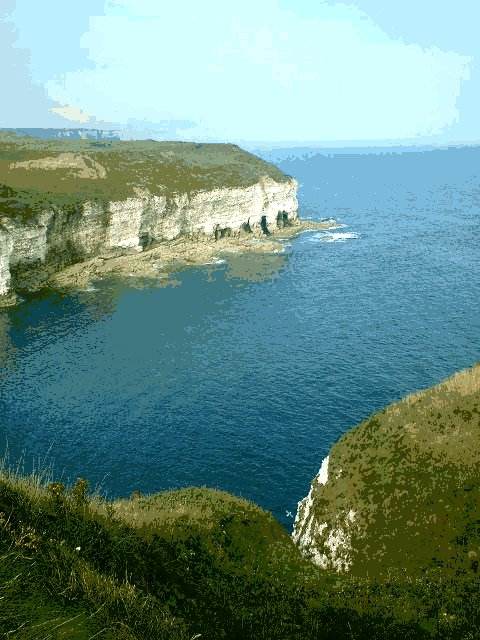
North Landing looking north.
Here we find Baines sitting in the sun:-
I have come out here to my beloved Flamboro' this morning
on my bike. The weather is perfectly gorgeous. I am sat writing on the
top of the cliffs, sat on an old very well initialled wooden bench overlooking
the North Landing. The lovely bay is before me and the white cliffs
are at their best in the sun.
Really I am enjoying it. The sea is at full
play, and the sheep are grazing here and there on the green cliff tops.
A low breeze blows through the grass, and flocks of birds go by. The
peace is getting into my soul. October 7th 1919
Of course we have no way of knowing what William Baines
was writing - most probably his diary.
There is one main work that was inspired by Flamboro'
Head - Tides - which consists of two pieces, The Lone Wreck
and Goodnight to Flamboro'. However a number of other works
seem to be related to this part of the coastline - the slow movement
of the Piano Sonata No. 2 in A minor is subtitled Sea Caves.
The first piece from the Suite Silverpoints is entitled Labyrinth
( A Deep Sea Cave) Other compositions suggest a sense of mood rather
than a descriptive tone poem; Twilight Pieces for Piano, Still
Day, Glancing Sunlight and Drift Light. The evocatively named
In the Tide Rip and Amid the Balmy Whispers of a July Night
show further infatuation with the sea. And then there was the setting
of Rossetti's poem By the Sea from the Five Songs
Why does the sea moan evermore?
Shut out from heaven it makes its moan,
It frets against the boundary shore;
All earth's full rivers cannot fill
The sea, that drinking thirsteth still.
Sheer miracles of loveliness
Lie hid in its unlooked-on bed:
Anemones, salt, passionless,
Blow flower-like; just enough alive
To blow and multiply and thrive.
Shells quaint with curve, or spot, or spike,
Encrusted live things argus-eyed,
All fair alike, yet all unlike,
Are born without a pang, and die
Without a pang, and so pass by. Christina Rossetti
Of course in this Georgian period it was common for
piano pieces to be given evocative titles. Very often the printed music
bore no audible relation to the striking title and cover picture of
the sheet. Yet with Baines we feel that although the titles may have
been devised to appeal to the publisher and the amateur market, there
was a considerable emotional and intellectual depth behind them.
There is something about the Lone Wreck that
defies description. On the one hand it is an extremely simple piece
- an Eb pedal construction, arpeggios with a tune 'floating above' yet
on the other hand it is a complex piece that explores some thoughts
that are perhaps to 'deep for words.' The 'tune' is given simply and
then with decoration. In some ways it is truly economical yet it sometimes
feels as if it encompasses an entire world of sound and timbre. The
score is prefixed with the words,
'In the hidden beach the deep sea rolls around the
lonely wreck;
Where the albatross with winds outspread-
White like the beaten foam,
Flies o'er and about the silent masts
All hung with seaweeds-
(and now toned with sungold)
Now I accept that there are probably very few albatrosses
flying in the North Sea skies. However it is not difficult to get the
picture as one looks down from the cliffs into hidden inlets and bays.
There are many shipwrecks off the coast of Bridlington.
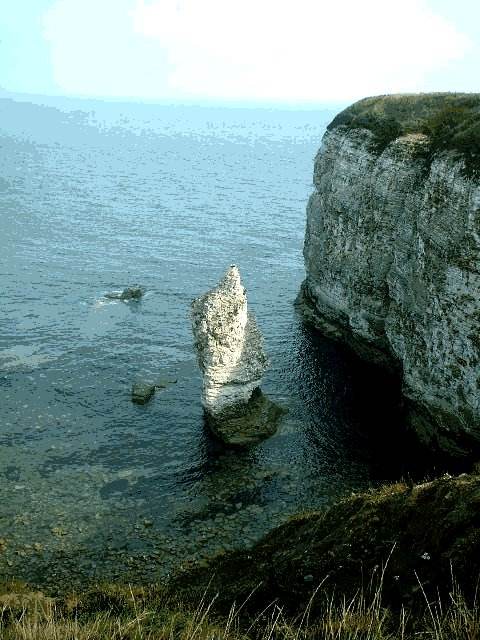
Stack at Breil Nook
William Baines has recorded the genesis of the second
piece in his diary entry for July 1st 1920,
Tonight I have written a lovely 'mind's eye impression'.
I got the idea from Colin Hunter's 'Goodnight to Skye'- only I have
written mine to my beloved Flamboro' - instead of Skye - and I call
this piece 'Goodnight to Flamboro' The waves persistently roll on the
rocks and in the caves… a beautiful ecstatic sorrow surrounds everything
about…only the sea can give that feeling. The last chords are a dream.
At the time he was trying to convalesce from his illness
at his Aunts in Bridlington. The score is inscribed with a quotation
from Edward Dowden: "Cry, Sea! it is thy hour; thou art alone."
The piece is constructed round an insistent semiquaver
pedal figuration - surely this is suggesting the murmur of the waves
as they roll into the base of the cliffs, and swirl around the stacks
and sea-caves. The music reaches a climax only to settle into darker
hues. Pedalling is supremely important in this piece - a shimmering
effect is created in the left hand throughout most of this piece. To
this listener's ear there are hints of John Ireland's music in these
pages. These two miniature tone poems or sea pictures are fine works
especially as the composer was only 21 years of age. They exhibit a
complete command of pianoforte technique and compositional skill. They
are neither too long nor too short; just perfectly balanced. Two of
the finest miniatures in the English piano repertoire.
As I came away turned for the last time from the high
cliffs of Flamboro' Head I saw a cormorant sitting on a half submerged
rock and thought of that wonderful but forgotten tone picture for piano
by Greville Cooke Cormorant Crag. Like William Baines his star
has set, yet perhaps one day someone like Roger Carpenter who is Baines'
biographer and champion or Eric Parkin who has well recorded a number
of his pieces, will do something to rectify this deficiency.
As for Baines, it is to be hoped that his piano works
will continue to attract a dedicated following, on CD if not in the
recital room or radio. And certainly there is a gap in the market for
his youthful symphony.
I tried to imagine how Baines felt as he turned his
back on Flamboro' for the last time. Perhaps he did not realise it was
farewell. I have no doubt that it was not far from his thoughts as he
entered his death agony, Earlier in his life he had written in his diary,
'Oh it is windy today…I was playing my Goodnight
to Flamboro' this afternoon -and what with the tremendous wind-smoke-and
rattling windows - it was realistic indeed! I could imagine myself
in the tall cold dripping caves (shivering of course!) listening to
the rumbling sea…and feel the serene silence which causes a wonderful
atmosphere (above the noise!) about such places. So rugged and wild
- the great banking waves tearing mountain high. What a scene - the
lonely seagulls the only sign of God!'
One hopes and prays that God allowed William Baines'
last thought to be 'How quiet and calm it will be at Flamboro today
amongst the caves -what joy to picture.'
John France
See also
GOODNIGHT TO FLAMBORO':
Piano Music of BAINES and GOOSSENS
William BAINES (1890-1922) Pictures
of Light (1920?); Glancing Sunlight (1920?); Island of
the Fay (1920?); Concert Study (Exaltation) (1919?); Idyll
(Nocturne) (1919); Elves (1919?); Paradise Gardens (1920);
Tides (1920)
Eugene GOOSSENS (1893-1962) Nature
Poems (1919)
 Alan Cuckston (piano)
Alan Cuckston (piano)
rec Leeds, 12 April 1990
 SWINSTY FEW 119CDr
[65.03] reviewed by Rob Barnett
SWINSTY FEW 119CDr
[65.03] reviewed by Rob Barnett

